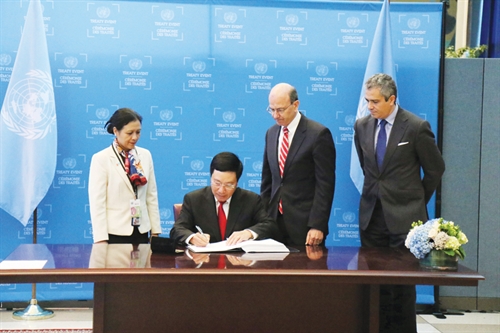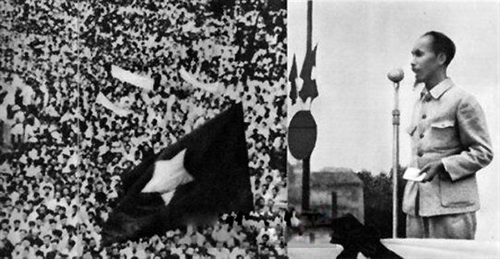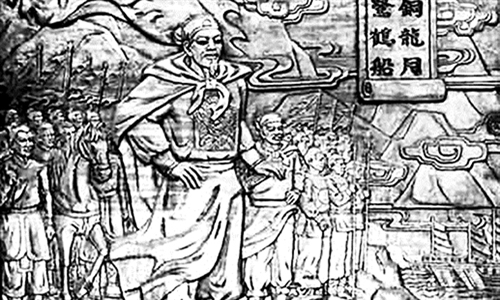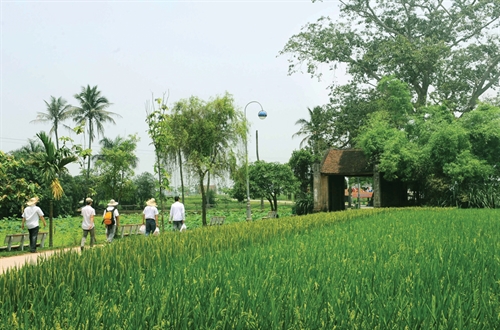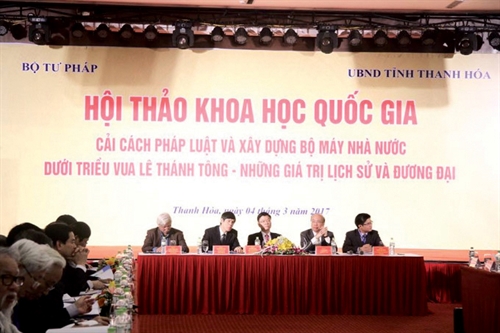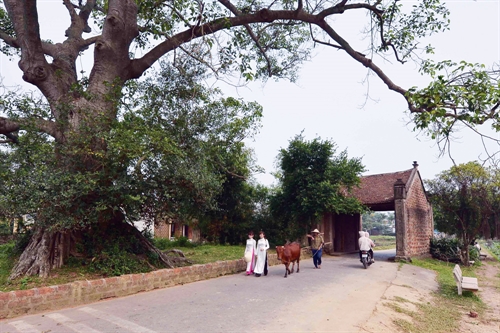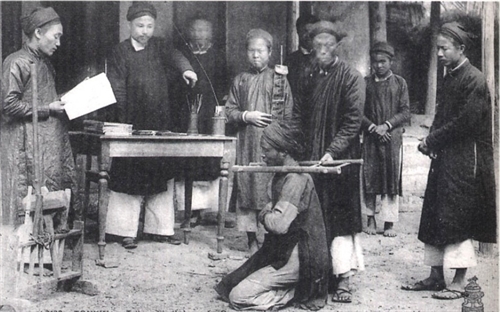In the historical process, the successive Vietnamese feudal states achieved steps of development in the way of organizing administrative divisions in the country to meet the requirements of social life and national defense. This writing dwells on the formation of administrative divisions in Vietnam from the Dinh dynasty onward and some lessons for the building of a law-ruled state at present.
Truong Vinh Khang
State and Law Institute
Vietnam Academy of Social Sciences
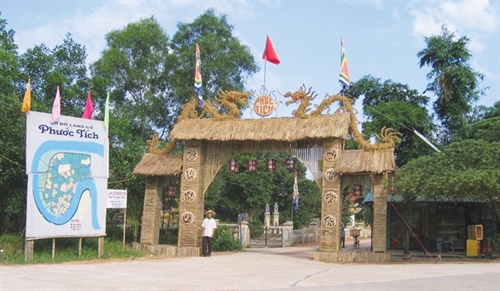 |
The gate of Phuoc Tich ancient village in Phong Dien district, Thua Thien-Hue province__Photo: Internet |
Formation of administrative divisions under different feudal dynasties in Vietnam
Along with the expansion and shrinking of the national territory, administrative divisions were formed. The formation of administrative divisions from the Dinh dynasty to Nguyen dynasty witnessed many changes in the ways of division and naming.
Under the Dinh dynasty (968-980), the country was divided into 10 “dao” (similar to provinces), which, in turn, were divided into “chau” or “dong” (districts). Although documents on these 10 specific “dao” have not yet been found so far, the records about the Dinh and Early Le dynasties have helped guess the names of “dao” in this period, including Bac Giang, Quoc Oai, Hai Dong, Hoan, Ai, Lam Tay, Dai Hoang, Dang, Thai Nguyen and Phong.
Yet, under the Early Le dynasty (980-1009), according to “Dai Viet Su Ky Toan Thu” (The Complete History of the Great Viet), in March 1002, King Le Dai Hanh renamed “dao” into “lo”, including “lo” Bac Giang, Quoc Oai, Hai Dong, Hoan, Ai, Lam Tay, Dai Hoang, Dang, Thai Nguyen and Phong. A number of administrative divisions under “lo” such as “phu” Do Ho and Thai Binh, and “chau” Ai, Thai Nguyen, Hoan Duong, Thach Ha, Do Luong and Thien Lieu were mentioned in this period.
In the Ly dynasty (1009-1225), the country was divided into a total of 24 “lo” in addition to “phu” and “chau”. However, “Cuong Muc” and “Toan Thu” (Complete Books of History) recorded the names of only 12 “lo” and 6 “phu”, including “lo” Thien Truong, Quoc Oai, Hai Dong, Kien Xuong, Khoai, Hoang Giang, Long Hung, Bac Giang, Truong Yen, Hong, Thanh Hoa and Dien Chau, and “phu” Do Ho, Ung Thien, Phu Luong, Nghe An, Thien Duc, and Truong Yen.
The Tran dynasty (1225-1400) divided local administrative divisions into “lo”, “phu” and “tran”, including “lo” Dong Do, Bac Giang, Lang Giang, Khoai Chau, Hoang Giang and Hai Dong; “phu” Tam Giang, Long Hung, Kien Xuong, Kien Hung, Tan Hung, Thien Truong and Nghe An; and “tran” Lang Son, Thien Quan, Quang Oai, Thien Hung, Thanh Do, Thai Nguyen, Tuyen Quang, Vong Giang, Tay Binh, and Thuan Hoa. The administrative divisions under “lo”, “phu” or “tran” were “chau”, and under “chau” were “huyen”.
Under the Late Le dynasty (1428-1788), King Le Thai To initially divided the country into four “dao”, then in 1428 into five “dao”, including “dao” Dong, Tay, Nam and Bac (corresponding to the present-day northern region) and Hai Tay (from Thanh Hoa to Thuan Hoa). Under “dao” were “tran”, “lo”, “huyen” and “chau” and the grassroots administrative unit was “xa”. In 1466, King Le Thanh Tong divided the country into 12 “thua tuyen” and changed “tran” into “chau” and “lo” into “phu”. The administrative divisions directly managed by the central administration were “thua tuyen”, and subsequently changed into “xu”. The size of “thua tuyen” or “xu” was equivalent to two to three present-day provinces.
From the early 17th century, Dai Viet (Great Viet) was divided into two territorial zones: Dang Ngoai (the North) and Dang Trong (the South). Dang Ngoai, which was ruled by the Trinh Lords, was divided into “tran”, for delta regions, and “phien tran”, for mountain regions. Meanwhile, Dang Trong was ruled by the Nguyen Lords, which initially covered the area from Thuan Hoa to Quang Nam and later expanded southward. By 1757, the southern territory had been shaped as at present, and divided into 12 “dinh” and one “tran” directly managed by the central administration. “Dinh” and “tran” were in turn divided into “phu” and “huyen”.
Under the Nguyen dynasty (1802-1945), King Gia Long divided the country into 23 “tran” and four “doanh”. Bac Thanh (present-day North Vietnam) comprised 11 “tran” organized into a “tong tran”. Central Vietnam comprised seven “tran” and four “doanh”. Gia Dinh Thanh (present-day South Vietnam) comprised five “tran” organized into a “tong tran”. From 1831-1832, King Minh Mang divided for the first time the country into 31 provincial-level administrative entities directly under the central administration, including 30 provinces and Thua Thien zone. Under the provincial level were “phu” and “huyen” (district), and the lowest level was “xa” (commune).
Factors affecting the administrative division of feudal Vietnam
The formation of administrative divisions in feudal Vietnam reflects the socio-economic development levels under different dynasties and is the objective development of history. Although there may be different explanations, such development process was affected by the following factors:
The first is the demand for state power centralization. The Confucian political ideology dictated the establishment of the Vietnamese monarchies, which developed from the pro-people military centralized regime under the Dinh and Early Le dynasties to the aristocratic centralized regime in the period of the Le and Tran dynasties, then to the bureaucratic centralized regime under the Le and Nguyen dynasties.
Prompted by the demand to concentrate the state power into the central administration, the feudal dynasties divided the country into administrative entities, from intermediary ones like “phu”, “chau” and “huyen” to grassroots ones. In the process of development of the feudal states, grassroots administrative divisions often enjoyed autonomy based on their natural population arrangements. They were gradually bureaucratized to become an administrative level in the national administrative system.
The second is the economic development requirement. The Vietnamese feudal states took shape and developed on the basis of feudal relations of production and the regime of title conferment. The feudal states, represented by the kings, possessed the national land and could lease or lend such land. The title conferment and land lease to mandarins, aristocrats and farmers greatly affected the formation of administrative divisions.
The Tran dynasty implemented the “dien trang - thai ap” (grant of farmstead-fief) policy to mandarins and aristocrats, which aimed at strengthening the aristocratic centralized monarchy. The society was divided into different classes: aristocracy, peasantry and handicraftsmen. Hence, the administrative divisions had to evolve to suit such historical reality. In 1242, under King Tran Thai Tong’s tenure, the country was divided into 12 “lo”. Under “lo” was “phu” or “huyen”. Each “phu” or “huyen” was divided into “xa”. Farmsteads granted to aristocrats could be located in one or several communes.
Under the Early Le dynasty, the way of establishing administrative divisions varied from that in the previous Tran dynasty. During this period, the state was a bureaucratic centralized monarchy with the economic foundation based on the state ownership over land and a professional administrative apparatus. A clear wage and bonus regime was applied to professional mandarins on the basis of land allocation. This greatly affected the establishment of administrative divisions. Along with the formation of administrative divisions at different levels of “dao” “phu”, “chau” or “huyen” and “xa”, land areas directly managed by the central administration were divided into plantation zones in order to meet the economic demands of the state itself. Such division was officially sanctioned in 1490 when King Le Thanh Tong established the administrative boundaries on state maps. Accordingly, the country had 13 “xu thua thuyen”, 52 “phu”, 178 “huyen”and 50 “chau”, and 6,851 “xa”.
Natural geographical location is the third factor having a role in the formation of administrative divisions and their naming. In delta regions, administrative divisions were named differently from those in mountain regions. For example, the intermediary level between the grassroots level (commune) and provincial level was called “huyen” in delta regions and “chau” in mountainous regions. As “huyen” were more populous than “chau”, the ways of organizing these administrative divisions were also different. Based on the natural conditions favorable for daily-life and production activities of local people, the state recognized and established administrative divisions at different levels. In newly claimed areas at estuaries, the state migrated people there to form new hamlets and establish new administrative entities. For instance, Tien Hai district in Thai Binh province and Kim Son district in Ninh Binh province were newly established administrative divisions.
Population size is the fourth factor affecting the formation and establishment of administrative divisions. Typically in the Le dynasty, communes were categorized into “tieu xa” (small communes), “trung xa” (medium-sized communes) and “dai xa” (great communes). A “tieu xa” was composed of under 50 households; a “trung xa” had between 50 and under 100 households; and a “dai xa” had 100 households. If a “dai xa” had its population swelling to over 100 households, it would be separated for establishment of a new “tieu xa”.
The last factor is war. The process of formation and development of feudal states in Vietnam was closely associated with the process of fighting against foreign invaders from the north and the south. The wars against northern invaders brought independence to the country while the wars against southern aggressors resulted in territorial expansion and the establishment of new administrative divisions in the south.
Lessons for the current process of building the state
From the formation of administrative divisions in feudal Vietnam we can draw some lessons for the current process of building the state.
First, the formation, separation and merger of administrative divisions should take into account the natural and social elements in order to ensure the economic development, maintain social stability and preserve traditional values. The formation of administrative divisions must conform with the management capacity of each administration level with a streamlined apparatus and skilled civil servants.
Second, the grassroots territorial divisions should be administralized in order to ensure that their activities comply with law and satisfy social-economic administration requirements and people’s demands and harmonize local and central interests.
Third, it is necessary to harmoniously combine the autonomy of grassroots administrative divisions and the people’s needs and the state’s laws.
Fourth, the state should build intermediary administrative divisions, namely districts, to be streamlined, operate effectively, satisfy the requirement of concentration of state power into the central administration while promoting democracy and bringing into play the autonomy of the local administration.-
__________
References:
1. Dang Xuan Bang (1997), Viet su cuong luoc tiet yeu (Brief chronicles of Vietnamese history), Social Science Publishing House, Hanoi.
2. Phan Huy Chu (2007), Lich trieu hien chuong loai chi (Classified Regulations of Dynasties), vol. 1 and 2. Education Publishing House, Hanoi.
3. Le Quy Don (1978), Dai Viet thong su (Complete history of Great Viet), Social Science Publishing House, Hanoi.
4. Vu Minh Giang (1993), Conclusions drawn from the specific traits of the history of Vietnamese political system, Science Journal, Hanoi University, issue No. 6.
5. Vu Minh Giang (1993), The relationship between traditional elements and the political system in the period of transition to socialism in our country, Theoretical Information Review, issue No. 7.
6. Vu Minh Giang (1994), ‘The law with non-official elements’, Society and Law, the National Politics Publishing House, Hanoi.
7. Tran Trong Kim (2005), Vietnam su luoc (Brief History of Vietnam), Ho Chi Minh City General Publishing House, Ho Chi Minh City.
8. Ngo Si Lien and the king’s envoys in the Le dynasty, Dai Viet su ky toan thu (Complete History of Great Viet), vol. 2 and 3. Social Science Publishing House, Hanoi.
9. Ngo gia van phai (1998), Hoang Le nhat thong chi (Unification records of Imperial Le), Literature Publishing House, Hanoi.
10. Nguyen Duc Nhue (1997), ‘Outline of administrative change and organization of local administration under King Le Thanh Tong’s reign’, Le Thanh Tong (1442-1497) - people and cause, Hanoi University Publishing House. Hanoi.
11. Quoc su quan trieu Nguyen (The Association of History of the Nguyen dynasty) (1998), Kham dinh Viet su thong giam cuong muc (The Imperially Ordered Annotated Text Completely Reflecting the History of Viet), vol. 1 and 2, Education Publishing House, Hanoi.-
